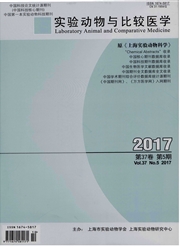

 中文摘要:
中文摘要:
目的探讨大鼠松果体N-乙酰基转移酶(NAT)基因的内源性昼夜节律表达。方法SD大鼠在持续黑暗fDD)光制下饲养8周后,在一昼夜内每隔4h采集一组松果体组织,提取总RNA,进行竞争性定量RT-PCR,测定不同昼夜时点(CT)样品中NAT基因mRNA的相对表达量,用余弦函数软件获取节律参数,并经振幅F检验分析是否存在昼夜节律。结果松果体NAT基因mRNA的表达呈现明显的内源性节律振荡(P〈0.05),峰值(mRNA水平为1.42±0、11)和谷值(mRNA水平为0.56±0.181分别位于CT17和CT5,峰值相位-260.85±9.45,振幅0.44±0.09,中值0.99±0.12。结论大鼠松果体NAT基因存在明显的内源性昼夜节律表达,其转录水平在主观黑夜高于主观白天。
 英文摘要:
英文摘要:
Objective To investigate the endogenous circadian expression of the Arylalkylamine Nacetyltransferase (NAT) gene in the rat pineal gland. Methods 36 SD rats under constant darkness (DD) for eight weeks were sampled for the pineal gland once every 4 hours in a circadian day. The total RNA was extracted from the samples and the semiquantitative reverse transcription polymerase chain reaction (RT-PCR) was used to determine the temporal changes in mRNA level of the NAT gene during different circadian times (CT). The data parameters were obtained and analysed by both the cosine function software and the amplitude F test to reveal the circadian rhythm. Results The NAT mRNA level in the pineal gland showed a significantly circadian oscillation (P 〈 0.05), with the peak (level is 1.42±0.11) at CT17 and trough (level is 0.56±0.18) at CT5. The parameter values of the peak phase, amplitude and mesor were -260.85±9.45, 0.44±0.09 and 0.99±0.12, respectively. Conclusion The endogenous circadian expression of NAT gene in the rat pineal gland is weak during the subjective daytime and robust at subjective nighttime under DD condition.
 同期刊论文项目
同期刊论文项目
 同项目期刊论文
同项目期刊论文
 期刊信息
期刊信息
